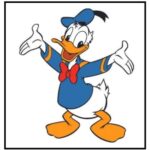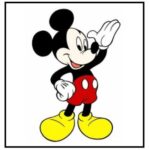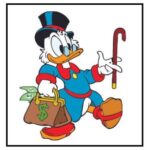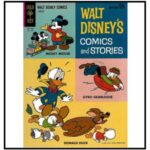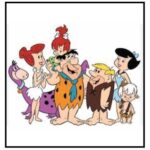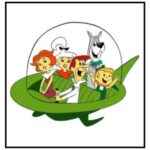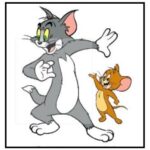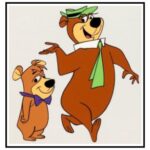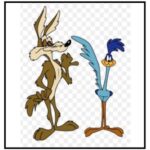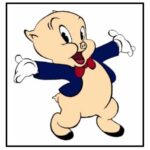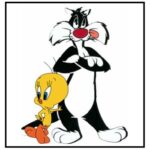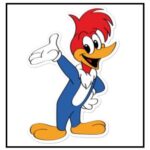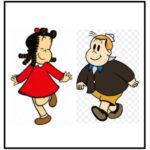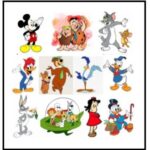Clicking on the following links or images will take you to the different comic collections of Gold Key cartoon characters covered in this section:
Although this section is about Gold Key Comics featuring cartoon characters, the foundation of these characters was laid by Dell Comics. In the early 1940s, Dell began acquiring the rights to many popular cartoon characters from various media franchises, including Disney, Hanna-Barbera and Looney Tunes. These characters included Mickey Mouse, Donald Duck and Bugs Bunny, among many others. With these in their portfolio, Dell started publishing a variety of comics featuring these popular characters, most of them making their debuts in Dell’s showcase publication Four Color Comics. Dell became well known for its colorful and well-produced comics, and their success allowed them to continue acquiring more characters and also publish original comics like Little Lulu and Beetle Bailey.
However, by the early 1960s, Dell decided to shift its focus away from comic books and sold its licensing rights to Gold Key Comics Starting in 1962, Gold Key continued to publish many of the same titles, often with similar styles and artwork, but added new characters and series to their lineup over the years. Gold Key Comics were a part of the portfolio of Western Publishing, and although the Gold Key brand was retired in 1980, the company continued to publish the comic books under the Whitman brand until 1984.
These comic books published by Gold Key (as well as its predecessor Dell and successor Whitman) comprised a cherished part of my childhood as I was growing up in the 1960s and 1970s. I have selected my favorite comic titles for inclusion on my lists, and I hope others will enjoy browsing through the lists I have compiled. I also have a large digital collection of comics and would be happy to share some of them with my fellow comic lovers – please fill out this form if interested.
Please see below for a brief summary of the different Gold Key cartoon comics covered on this site (in chronological order of the first appearance of each character).
Donald Duck (1940): The first Donald Duck comic book comprised of reprinted newspaper strips was published by Dell in Four Color Comics in 1940, followed by many others with original stories. A decade later, Dell introduced the Donald Duck title, which continued until it was taken over by Gold Key Comics in 1962. The Gold Key series lasted until 1984. Among the contributors the series was the writer-artist Carl Barks, who is widely considered to be one of the greatest comic book creators of all time.
Walt Disney’s Comics & Stories (1940): This anthology of Disney character stories, also known as WD C&S, is one of the longest-running comic book series in history. It was first published by Dell Comics in 1940 and continued under the Dell brand until 1962, and under the Gold Key/Whitman brand until 1984. The comics featured a variety of established Disney characters like Donald Duck and Mickey Mouse, and also introduced new characters such as Chip ‘n’ Dale and Scamp. The legendary Carl Barks mentioned above was a major contributor to the series for many years.
Bugs Bunny (1941): Bugs Bunny is one of the most iconic characters in the world of animation and comics. The character first appeared in a Warner Bros. cartoon in 1940 and soon became a cultural icon. In 1941, Dell published the first Bugs Bunny comic book written and illustrated by Chase Craig. The comic continued under the Dell brand until 1962, and under the Gold Key/Whitman brand until 1984.
Mickey Mouse (1941): Mickey Mouse is one of the most beloved characters from the Disney universe and has had a long and storied history in the world of comics. The first Mickey Mouse comic book was published by Dell in Four Color Comics in 1941. The Mickey Mouse comic continued under the Dell brand until 1962, and under the Gold Key/Whitman brand until 1984. The artist best known for his rendition of Mickey Mouse in comic books was Paul Murry, who drew the covers and interior art for over thirty years.
Porky Pig (1942): Porky Pig is a classic Looney Tunes character who first appeared in animated short films in the mid-1930s. He later made his debut in comic books, appearing in many Four Color Comics in the 1940s and eventually getting his own Dell title in 1952. The title continued under the Dell brand until 1962, and under the Gold Key/Whitman brand until 1984. Porky was often accompanied in his adventures by other well-known characters such as Daffy Duck and Bugs Bunny.
Tom & Jerry (1942): The classic animated series Tom and Jerry was created by Hanna-Barbera in 1940 for MGM. The series features the iconic cat Tom and his never-ending pursuit of the elusive mouse Jerry (along with his companion Tuffy), resulting in a series of comedic hijinks and slapstick gags. Tom and Jerry began appearing in Our Gang Comics in 1942, published by Dell. The title of the comic was eventually changed to Tom & Jerry, and the comic series continued under the Dell brand until 1962, and under the Gold Key/Whitman brand until 1984.
Woody Woodpecker (1942): This classic animated character was created by Walter Lantz in 1940 and was featured in numerous cartoons that became very popular. In the early 1940s, Woody Woodpecker began to appear in comic books published by Dell Comics, eventually getting his own Dell title in 1952. The title continued under the Dell brand until 1962, and under the Gold Key/Whitman brand until 1983. Throughout their history, the Woody Woodpecker comics maintained the same charm and humor as the animated cartoons, making it a popular series among fans of all ages.
Little Lulu (1945): Lulu Moppet first appeared in the Saturday Evening Post in 1935 and later made her way into comic books. She made her comic-book debut in Dell’s Four Color Comics in 1945 and shortly thereafter got her own Dell comic title. The series continued under the Dell brand until 1962, and under the Gold Key/Whitman brand until 1983. The primary creative force responsible for developing the Little Lulu character over many decades was writer-artist John Stanley, who is widely regarded as one of the greatest creators in comic book history.
Tweety & Sylvester (1952): This classic Looney Tunes series made its comic-book debut in Four Color Comics in 1952 and shortly thereafter got its own title which continued until 1962 under the Dell brand, and until 1984 under the Gold Key/Whitman brand. The Tweety & Sylvester comics mostly consisted of humorous stories featuring Tweety and Sylvester engaged in a never-ending feud and have provided readers with countless laughs and heartwarming moments over the years.
Uncle Scrooge (1952): Uncle Scrooge is a popular character in the Disney universe, known for his stinginess and his love of wealth and adventure. He first appeared in several issues of Four Color Comics and eventually received his own Dell Comics title in 1952. The series ran until 1962 and featured a variety of writers and artists, but the vast majority of the stories were created by the legendary cartoonist Carl Barks, best known for his work on Donald Duck. The comic was taken over by Gold Key Comics in 1962 which ran for over two decades and lasted until 1984.
Beetle Bailey (1953): This classic comic strip character created by Mort Walker in 1950. The character is a lazy and hapless soldier who spends most of his time avoiding work and annoying his sergeant. Beetle Bailey made his comic-book debut in the Dell publication Four Color Comics in 1953, and shortly thereafter graduated to having his own Dell comic title. The series continued under the Dell brand until 1962, and under the Gold Key brand until 198o. Beetle Bailey was among the few comics that was mainly produced by its original creator (Mort Walker) during almost its entire history.
Daffy Duck (1953): He is one of the most popular characters from the Looney Tunes universe, known for his zany antics and off-the-wall humor. He made his debut in the Dell publication Four Color Comics in 1953, and shortly got his own Dell comic title, which continued until 1962 under the Dell brand, and until 1984 under the Gold Key/Whitman brand. For much of its history, the principal illustrator for Daffy Duck was Phil De Lara, who shaped the look and feel of the character.
Beep Beep the Road Runner (1958): Along with his adversary Wile E. Coyote, Beep Beep is another famous character from the Looney Tunes universe. He made his debut as a supporting character in Bugs Bunny Vacation Funnies, followed by his own series of adventures in Four Color Comics. He eventually getting his own Dell title in 1960, which lasted for a couple of years until Gold Key (later Whitman) took it over in 1962, and continued it until 1984.
Yogi Bear (1959): This beloved character was created by Hanna-Barbera for an animated TV show in 1958. Yogi made his comics debut in Dell’s Four Color Comics the following year and got his own Dell title two years later. Within a year, Gold Key had taken over the comic and they continued publishing the series until 1970. The comics featured Yogi and his sidekick Boo Boo getting into various comical situations in Jellystone Park and they have remained popular among fans of all ages.
The Flintstones (1961): Like Yogi Bear, the Flintstones also started as a classic animated television series by Hanna-Barbera that aired from 1960 to 1966, which led to a series of comic books. The first Flintstones comic was published by Dell Comics in 1961, and the series transitioned to Gold Key Comics in late 1962 and then continued for many issues until 1970. The comic books featured the Flintstones and the Rubbles in a variety of comedic adventures that were similar in style to the TV show, and they have remained a beloved part of the franchise’s history.
The Jetsons (1963): This was another popular Hanna-Barbera TV show which spawned a series of comic books. The first Jetsons comic was published by Gold Key Comics in 1963, and the series continued until 1970. The stories featured the Jetson family in a variety of comic adventures with a robot maid, flying cars and futuristic technology. The Jetsons comics were very popular during their time and continue to be cherished by fans of the show and collectors of vintage comic books.

